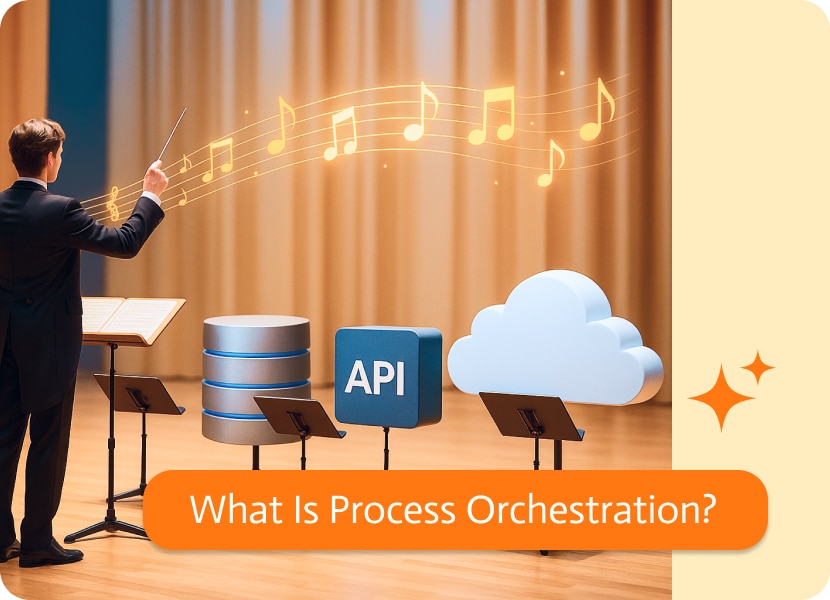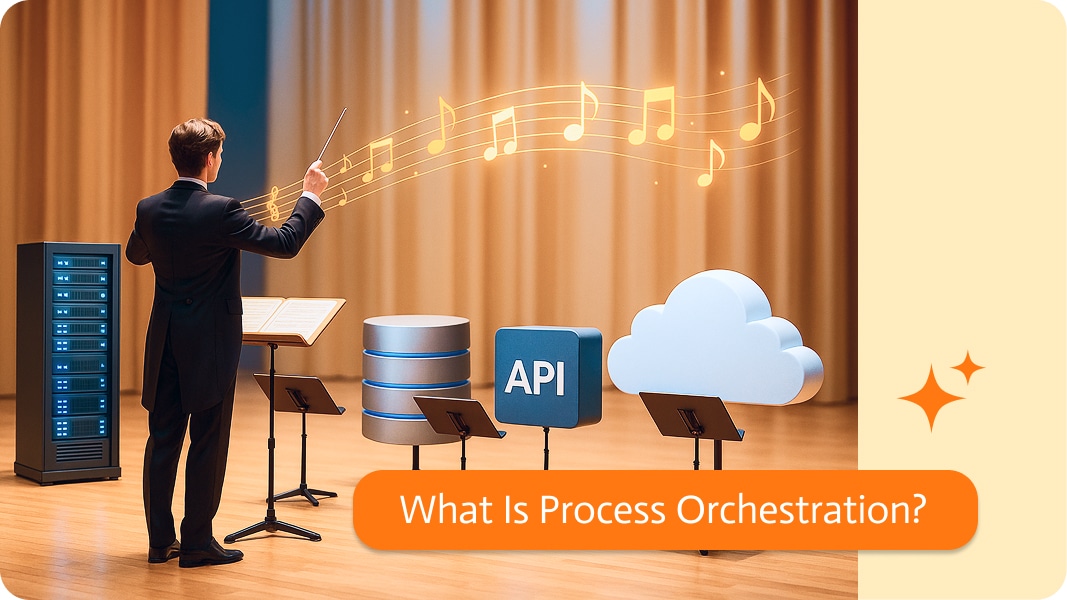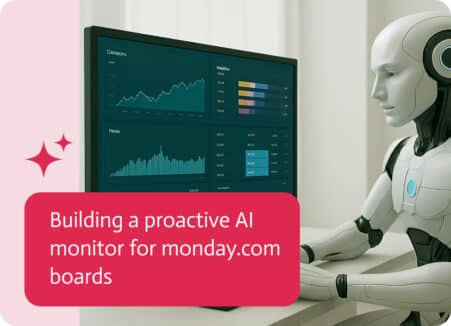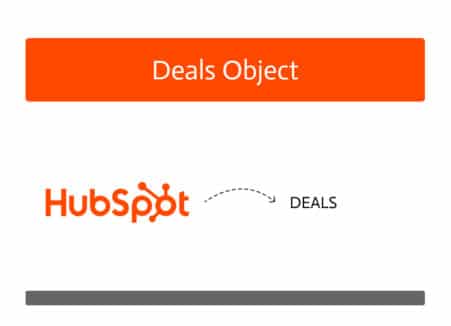

What Is Process Orchestration?
Think of process orchestration as the conductor of your business workflows. Instead of automating one isolated task (like sending an email when a form is filled), orchestration strings together multiple, interdependent steps, across people, systems, and data, into a smooth, end-to-end performance. It doesn’t just flip switches; it decides the order, handles exceptions, loops back when something fails, and even inserts human approvals when needed.
Key characteristics of process orchestration:
- End-to-end coordination: Orchestration oversees an entire workflow, from kick-off through every conditional branch to completion, rather than automating discrete pieces.
- Cross-system integration: It talks to CRMs, ERPs, databases, messaging services, RPA bots, ensuring data and actions flow where they need to without manual handoffs.
- Dynamic decision-making: Built-in logic routes work based on real-time data (for example, escalating a ticket if it’s not addressed within SLA or sending high-value leads straight to senior sales reps).
- Exception handling & monitoring: It catches errors, retries steps, alerts humans when intervention is needed, and logs every move for optimization.
Why it matters:
- Faster, more reliable outcomes: By knitting together every piece of a process, orchestration slashes cycle times and cuts down “who does what next?” confusion.
- Greater visibility: Dashboards show you exactly where any process instance is (e.g., “invoice #123 is waiting on legal review”), so nothing disappears randomly.
- Scalability & resilience: When adding new systems or tweaking steps, you simply update the orchestration flow—no more brittle point‐to‐point scripts that break whenever something changes.
Real-world examples:
- Order-to-Cash: Orchestrating order entry, inventory checks, payment processing, shipping notifications, and invoicing into one seamless flow.
- Onboarding New Employees: Automating ID creation, benefits enrollment, equipment ordering, manager notifications, and training assignments in a single run.
- IT Incident Management: Detecting alerts, creating tickets, escalating to experts, running remediation scripts, and closing the loop with status updates.
Process orchestration stands apart from other approaches to automation and process management primarily in its holistic and end-to-end perspective. While related concepts focus on individual tasks or specific parts of a process, orchestration aims to coordinate and manage an entire business process, often spanning multiple systems, applications, and even human participants.
Using Noca To Simplify Process Orchestration
Without the need for coding expertise, Noca AI serves as an advanced central coordinator, tying together a company’s many different software systems, including online storefronts, finance, and sales. By facilitating smooth information exchange between various applications, it allows users to visually design and automate entire operational sequences, from customer inquiries to order fulfillment.
Its use of “AI agents”—which are more than just pre-programmed rules—is a key differentiator. These agents can learn, make suggestions for improvements, and adjust procedures in real-time, making operations more intelligent and adaptable to change. This platform allows businesses to monitor process health, identify problems, and continuously improve workflows for increased efficiency and agility. It does this by integrating systems, automating tasks, and providing comprehensive oversight and control.
Process Orchestration vs. Process Automation (or Task Automation)
Process Automation:
Focuses on automating individual, repetitive tasks within a process. Think of it as automating a single “note” in a symphony.
Examples:
Automatically sending an email, copying data from one spreadsheet to another, and generating a report.
Process Orchestration:
Takes a broader view, coordinating and managing multiple automated tasks, human activities, and systems to achieve a larger business objective. It’s like being the “conductor” of the symphony, ensuring all the individual “notes” (automated tasks) play in harmony and in the correct sequence to produce a complete piece.
Key difference:
Automation handles what happens in a single step; orchestration dictates when and how multiple steps interact to complete a full process.
Process Orchestration vs. Workflow Automation
Workflow Automation:
Automates a predefined sequence of tasks within a single workflow. It often involves routing documents, approvals, and notifications. While it has a broader scope than simple task automation, it typically stays within a single system or a limited set of integrations.
Process Orchestration:
Encompasses workflow automation but extends beyond, allowing it to deal with intricate scenarios that involve disparate systems, external applications, and dynamic decision-making. Orchestration can connect multiple workflows, manage dependencies across them, and handle changes in real-time.
Key difference:
Workflow automation is often about automating a linear or branching path within a defined process; orchestration is about connecting and managing of interconnected systems to achieve a larger business outcome, even if those processes aren’t strictly linear.
Process Orchestration vs. Business Process Management (BPM)
Business Process Management (BPM):
Is a strategic discipline which is focused on designing, modeling, analyzing, optimizing, and continuously improving business processes. It’s a holistic way to process improvement that uses people, technology, and methods. BPM often involves process mapping, analysis, and re-engineering.
Process Orchestration:
Is a component or enabler within the broader BPM framework. While BPM provides the strategic blueprint and design for processes, process orchestration provides the tools and capabilities to actually execute and manage those processes, especially the automated and integrated parts.
Key difference:
BPM is about how a business process should ideally work and how to improve it; process orchestration is about making that ideal process work in practice, coordinating all the technical and human elements. BPM is the “architect,” and orchestration is the “construction manager.”
Process Orchestration vs. Robotic Process Automation
Robotic Process Automation (RPA):
Utilizes “bots” to mimic human interactions with digital systems (e.g., clicking, typing, data entry). RPA is excellent for automating highly repetitive, rule-based tasks that often involve legacy systems without APIs.
Process Orchestration:
Can leverage RPA bots as one of its tools, but it’s not limited to them. Orchestration can coordinate RPA bots with other technologies like APIs, AI/ML services, human tasks, and various enterprise systems to achieve a complete end-to-end process.
Key difference:
RPA automates specific human-like interactions; orchestration coordinates all types of interactions (human, system, bot) across an entire process. RPA is a single instrument; orchestration is the conductor of the entire orchestra, which may include RPA instruments.
Process Orchestrations Distinguishing Features
Coordinated End-to-End Workflows:
Process orchestration isn’t just about automating one tiny task. It’s about managing a whole business operation from beginning to end. Imagine entering a customer order. It doesn’t just automate the entry or print a shipping label. It takes care of everything: the order, checking stock, payment, picking the stuff in the warehouse, shipping it, telling the customer, and checking in after it gets there.
When you do this, you line up all the tasks and systems to smash those company goals, instead of doing stuff separately that causes issues and gaps in info. Nowadays, business info is usually all over the place – CRM for sales, ERP for finances, special tools for shipping, and marketing stuff too. Process orchestration is like the thing that glues it all together.
It helps connect modern systems with older ones so info moves without trouble throughout the company. This gets rid of having to manually copy data, cuts down on mistakes from retyping, and makes sure every system uses the most up-to-date info to do its thing.
Management of Human-in-the-Loop
Almost all business processes require human decisions, intervention, or approval at some stages. Process orchestration incorporates these human decision points and interventions in automated flows. For instance, a complex loan application could be largely automated while routing high-value approvals to a human manager, or if there is an exception, alerting a human for review and resolution. This approach combines the speed of automation with the intelligence of human minds.
Of course, in any management system that has humans as part of it must also take into consideration their limitations and factors that they cannot perform efficiently. This is why process orchestration acknowledges that some decisions cannot be, nor should they be, automated; rather, they should be made by people who know what works best for them. The managers have to deal with their direct reports on a one-on-one basis to sort issues out in case problems arise with employees not used to working collaboratively.
Human-in-the-loop management is essential when handling exceptions because it allows access to data and systems even beyond the limits of automation, enabling quick bypassing of more complex scenarios compared to when trying to automate everything according to rules. Therefore, business process orchestration allows control over certain steps within an automated flow but ultimately provides transparency into how transactions are moving through the various channels and what actions have been taken on each transaction within any specific channel, given its integrated nature with BPM systems.
Dynamic adaptation is a key factor in the business world as regulations shift, customer demands change, and unexpected events happen. Process orchestration is designed to handle these exceptions, changes, and unpredictable events in real time. In case of an error on a standard automated path, emergence of a new condition, or unavailability of a critical resource, the orchestration layer can automatically redirect tasks, trigger alternative actions, or alert concerned personnel. This ensures that processes are resilient and flexible with a minimum amount of disruptions; hence, businesses are able to promptly respond to unforeseeable circumstances without having them come to a halt.
Visibility and control
One of its major benefits is the view that it gives you into the entire process. Process orchestration platforms usually provide an interface or central dashboard that summarizes the whole process flow. You can see what stage each task is in, identify where there may be hold-ups, track KPIs, and audit every step. With this level of visibility, meticulous monitoring becomes possible, thereby helping organizations detect inefficiencies, understand their resource use patterns, and identify areas for improvement. Organizations which have achieved such levels of control can proactively optimize their processes through fine-tuning performance to ensure compliance.
The Verdict
Process orchestration enables organizations to go beyond task automation and achieve end-to-end automation by offering this overall coordination. This holistic approach enhances operational efficiency through eliminating manual hand-offs, shortening cycle times, and streamlining workflows. Consequently, it minimized errors by reducing human intervention in repetitive tasks. Thus, the organization can be very agile to adapt itself according to changing business needs, as processes could be quickly adapted, scaled, and reconfigured in order to meet new challenges and opportunities.


